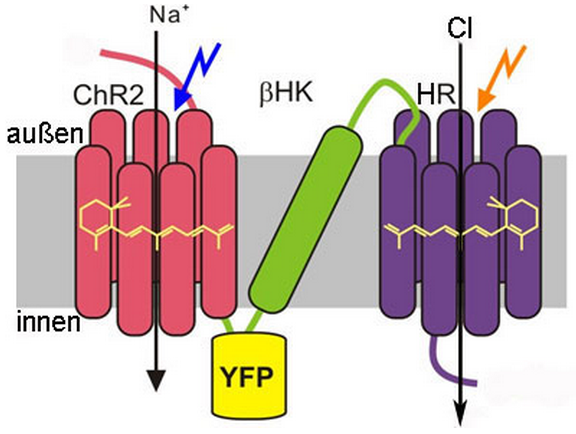Optogenetics switch turns neurons on and off
January 4, 2012

Molecular combination switch: two light-sensitive membrane proteins (red and purple) are linked via a connecting piece (green) and anchored into the cell wall. When the cell is illuminated with blue light, it allows positively charged ions into the cell. Orange light allows negatively charged ions in. The cell is activated or deactivated, respectively. (Credit: MPI of Biophysics)
A research team at the Max Planck Institute of Biophysics in Frankfurt am Main has developed a molecular light switch that makes it possible to control cells more accurately than ever before.
The combination switch consists of two different light-sensitive membrane proteins — one for on, the other for off.
Optogenetics is a new field of research that aims to control cells using light, using light-sensitive proteins that occur naturally in the cell walls of certain algae and bacteria. They introduce genes with the building instructions for these membrane proteins into the DNA of target cells. Depending on which proteins they use, they can create on and off switches that react to light of different wavelengths.
For accurate control, it is important that the cell function can be switched off and on equally well. When the genes are introduced separately, the cell produces different numbers of copies of each protein and one type ends up dominating.
Max Planck Institute of Biophysics scientists have now developed a solution that locates the genes for the on and off proteins on the same portion of DNA, along with an additional gene containing the assembly instructions for a connection piece. This interposed protein links the two switch proteins and anchors them firmly in the cell membrane.
The combination light switch conceived by the researchers consists of the membrane proteins channelrhodopsin-2 and halorhodopsin. Channelrhodopsin-2 reacts to blue light by making the cell wall permeable to positively charged ions. The resulting influx of ions triggers a nerve impulse that activates the cell. Halorhodopsin has the opposite effect: when the cell is illuminated with orange light, it allows negatively charged ions in, suppressing nerve impulses.
Since channelrhodopsin-2 and halorhodopsin react to light of different wavelengths, together they comprise a useful tool for switching cells on and off at will. The scientists have shown that the method they used to connect the two molecules is also suitable for use with other proteins.
Ref.: Sonja Kleinlogel et al., A gene-fusion strategy for stoichiometric and co-localized expression of light-gated membrane proteins, Nature Methods, 2011 [doi: 10.1038/nmeth.1766]
